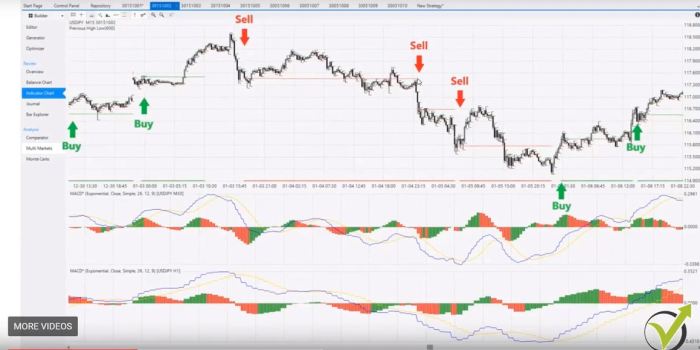Forex algorithmic trading empowers traders to automate their strategies, leveraging technology to navigate the complexities of the currency market. Dive into the world of algorithmic trading and unlock the potential for enhanced precision, efficiency, and profitability.
Forex algorithmic trading involves using automated systems to execute trades based on predefined rules. These algorithms can be designed to identify and exploit various market patterns, such as the Range trading strategy , which involves buying and selling within a defined price range.
By automating these strategies, Forex algorithmic trading allows traders to capitalize on market opportunities without the need for constant manual monitoring.
This comprehensive guide delves into the intricacies of forex algorithmic trading, providing a roadmap for developing, implementing, and managing automated trading systems.

Explore the different types of algorithmic trading strategies, learn the art of strategy design and optimization, and gain insights into the latest trends shaping the future of algorithmic trading.
1. Introduction to Forex Algorithmic Trading
Forex algorithmic trading, also known as algo trading, is a method of automating trading decisions based on predefined rules and algorithms. It involves using computer programs to analyze market data, identify trading opportunities, and execute trades without human intervention.
Algorithmic trading strategies can range from simple trend-following systems to complex models that incorporate machine learning and artificial intelligence. They offer several benefits, including reduced emotional bias, increased efficiency, and the ability to trade around the clock.
However, algorithmic trading also has drawbacks, such as the need for technical expertise, the potential for system failures, and the risk of over-optimization.
2. Types of Forex Algorithmic Trading Systems
Trend Following Systems
Trend following systems identify and trade in the direction of prevailing market trends. They use technical indicators, such as moving averages and trendlines, to determine the trend and enter or exit trades accordingly.
Mean Reversion Systems
Mean reversion systems assume that asset prices tend to return to their average value over time. They buy assets when they fall below their average and sell when they rise above it.
Forex algorithmic trading employs automated systems to execute trades based on pre-defined rules. These algorithms aim to maximize profits and minimize losses. Forex profit targets play a crucial role in algorithmic trading, as they determine the point at which a trade should be closed to secure profits.
By integrating profit targets into their algorithms, traders can optimize their trading strategies and increase their chances of success.
Arbitrage Systems
Arbitrage systems exploit price discrepancies between different markets or instruments. They buy an asset in one market and simultaneously sell it in another at a higher price, profiting from the difference.
3. Developing a Forex Algorithmic Trading Strategy
Strategy Design
Developing an algorithmic trading strategy involves defining the trading rules, parameters, and risk management guidelines. It is crucial to identify the target market, trading instruments, and timeframe.
Testing and Optimization
Once the strategy is designed, it should be thoroughly tested using historical data to assess its performance and identify areas for improvement. Optimization involves fine-tuning the parameters and rules to maximize profitability.
Data Sources and Metrics
Choosing appropriate data sources is essential for accurate market analysis. Metrics such as Sharpe ratio, profit factor, and maximum drawdown should be used to evaluate strategy performance.
Forex algorithmic trading involves using automated systems to analyze market data and execute trades. To get started with this approach, you’ll need to open a forex account. This account will allow you to deposit funds and start trading. Once you have an account, you can choose from various algorithmic trading platforms and strategies to automate your trading process.
4. Implementing and Managing Forex Algorithmic Trading Systems
Implementation, Forex algorithmic trading
Implementing an algorithmic trading system involves connecting it to a trading platform and ensuring proper communication between the system and the broker.
Risk Management and Monitoring
Effective risk management is crucial to mitigate potential losses. It involves setting stop-loss levels, position sizing, and monitoring the system’s performance in real-time.
System Maintenance and Troubleshooting
Regular system maintenance is necessary to ensure its stability and performance. Troubleshooting involves identifying and resolving any errors or issues that may arise.
Closing Summary
Embark on the journey of forex algorithmic trading, armed with the knowledge and strategies Artikeld in this guide. Embrace the power of automation to streamline your trading operations, optimize your performance, and achieve consistent success in the ever-evolving forex market.
Answers to Common Questions
What are the benefits of forex algorithmic trading?
Forex algorithmic trading offers numerous benefits, including increased precision, reduced emotional bias, 24/7 trading capabilities, and the potential for enhanced profitability.
What types of algorithmic trading strategies exist?
There are various types of algorithmic trading strategies, such as trend following, mean reversion, arbitrage, scalping, and high-frequency trading, each with its unique characteristics and advantages.
How do I develop a robust forex algorithmic trading strategy?
Developing a robust algorithmic trading strategy involves defining trading objectives, identifying market inefficiencies, selecting appropriate data sources, designing and testing trading rules, and optimizing strategy parameters.




